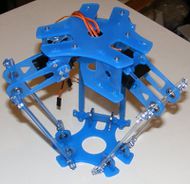Enemy Delta Robot
Release status: experimental
| Description | Delta Robot by EnemyGadgets
|
| License | ???
|
| Author | |
| Contributors | |
| Based-on | |
| Categories | |
| CAD Models | |
| External Link |
Contents
Enemy Delta Robot
This delta robot based on work from http://www.enemygadgets.com/delta/index.html
The aim is a cheap delta robot anyone can make with the reprap, laser or routing cutters.
Second aim - make light weight micro extruder specifically for small delta robots.
Third aim - build robot to enter the Gada Prize by becoming inherently cheap to build.
Fourth aim - build a PIC based controller with USB and G-code interpreter that is compatible to reprap software
I need to build a reprap to play with, so I get to know how it works better. As I learn more, I intend to start to build some variant(s) of existing reprap machine. I can then get some of the difficult to make parts from others who make it already in case I run into brick wall with my limited tech.
Lightweight Extruder
The biggest headache I can see in this project is getting a micro extruder going that doesn't weigh down the delta robot. Some commercial delta robots can operate at 200 operations per second. The only things that weigh them down are eliminated by using carbon fibre rods.
Fitting a bulky extruder and mechanisms to feed it and heavy current carrying wires for the heater ain't gonna get a fast delta robot. A micro extruder for this delta robot has to go back to the drawing board to address all the issues that it generates.
The first idea for extruder is needle and soldering iron. That won't work apparently because needles are long and pressure to squirt material through long needles is high. To lower the pressure the final hole needs to be one or two millimetres. So make it the usual way reprappers do.
The second idea is to break down water with electricity to make hydrogen and oxygen and then find a high temperature double hose. The inside hose will carry the melt, while the outside hose will have this hydrogen/oxygen mix ignited keeping the inner hose hot. That way, the melting takes place far away from the delta robot's moving head and this keeps the mass of the head small so that the delta robot can wizz around at its natural horrendously fast speeds.
The hydrogen/oxygen scheme may be a little extreme, but the principle of a double hose has value. For example, if a high temperature hose can be made, then the outside hose can be a coil of nichrome wire and it can keep the inner hose hot and the plastic melt inside that as hot as needed.
- As of 2010, the lightest extruders designed so far are in the Category:Bowden Extruders category. Perhaps one of them will be adequate for the first prototype.
Mendel Ordered
Ordered a Mendel to get to grips with rep rap.
Light Weight Extruder - The Real Challenge
The Delta robot mechanism was never a challenge. Can design cut and make one in about a day. The real challenges that remain are a PIC based G-code interpreter (a small challenge), and that light weight extruder. The entire moving parts of the extruder head must weigh a lot less than a 1p coin! Otherwise there is no point in attaching a delta robot to drive the head.
I'm raking my brains endlessly on this. The Bowden does seem the best bet at the moment. A heat resistant PTFE tube some 300mm long will carry the fuse, and then the heat at the brass head will melt the fuse and squirt it out. Crucially, the motor for pushing the fuse into the melt is not on the moving platform of the head, thereby reducing the weight of the moving head platform to just that of the weight of the brass head and any fixings. It is those fixings and weight of the head that has to controlled to bring it under the weight of a 1p coin to take full advantage of the speed of a delta robot.
